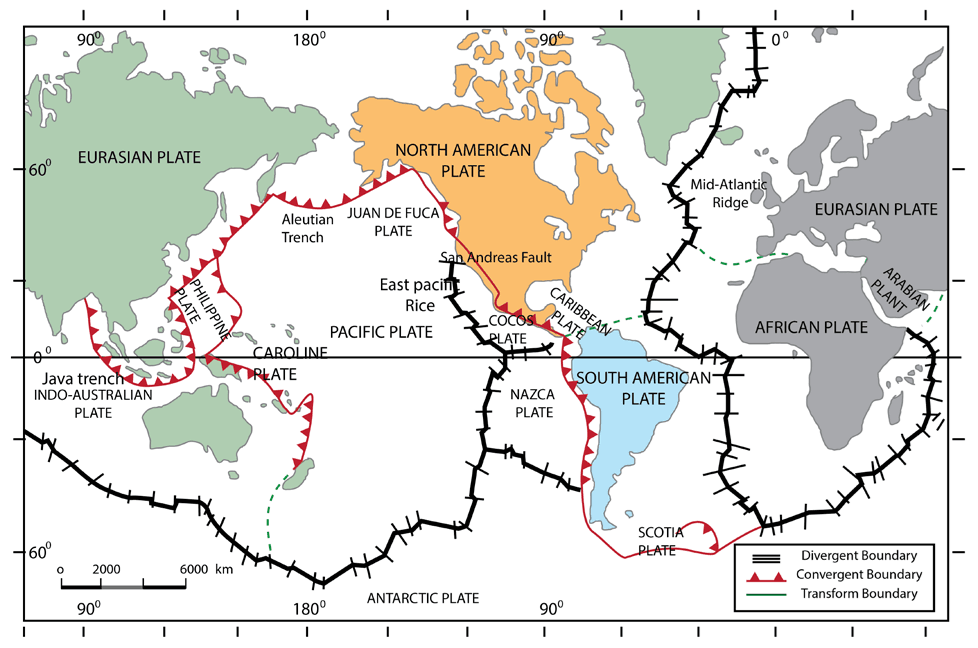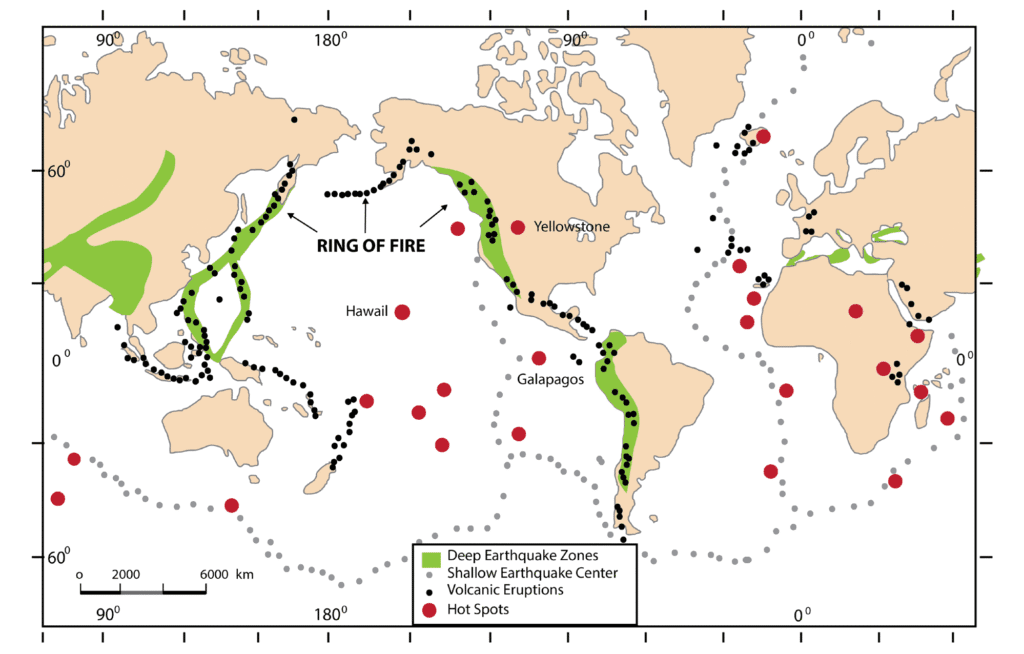Plate Tectonics
The theory of plate tectonics explains how Earth’s outer shell is divided into large, moving pieces called lithospheric plates. These rigid plates float on the partially molten mantle beneath them, constantly moving at rates of 2-15 cm per year. The theory, developed in the 1960s by McKenzie, Parker, and Morgan, describes how new oceanic crust forms at mid-ocean ridges while old crust is destroyed at subduction zones, creating earthquakes, volcanoes, and mountain ranges.
- The theory of plate tectonics currently represents the most universally acknowledged framework among geologists.
- The fundamental concept posits that, rather than being permanent features of the Earth’s surface, both continents and oceanic basins are subject to continuous transformation.
- Each constitutes segments of lithospheric plates that interact dynamically; during these interactions, new crust is generated at mid-oceanic ridges (spreading centers), while older crust is subducted at convergent plate boundaries (subduction zones).
- This theory asserts that the Earth’s outer shell is partitioned into multiple plates that glide atop the mantle, the rocky internal layer situated above the core. These plates function as a rigid and hard shell in contrast to the underlying mantle. This robust external layer is termed the lithosphere.
- In 1967, McKenzie and Parker introduced the theory of plate tectonics, which was subsequently elaborated by Morgan in 1968.
- By this period, the continental drift theory was entirely supplanted by the emergence of the convection current theory and the seafloor spreading theory.
- Both the convection current theory and seafloor spreading were crucial in paving the way for the Plate Tectonics theory.
- The lithosphere encompasses both the crust and the uppermost mantle.
- Oceanic plates predominantly consist of Simatic crust and are relatively thin. Conversely, continental plates, which are composed of Sialic material, are thicker.
- Lithospheric plates (alternatively referred to as crustal plates or tectonic plates) range from minor to major plates, including continental plates (e.g., Arabian plate), oceanic plates (e.g., Pacific plate), and composite plates containing both continental and oceanic components (e.g., Indo-Australian plate).
- The movement of these crustal plates is essential for the genesis of diverse landforms and constitutes the primary driver of all terrestrial movements.
- Plate tectonics exerts significant influence on human existence in several important respects: » They are the principal cause of earthquakes. » Volcanic activity is a direct result. » They facilitate the recycling of elements within the biosphere and between the geosphere and biosphere. » They are crucial for orogenesis (mountain-building).
- Plate Movement Rates » The East Pacific Rise in the South Pacific (approximately 3,400 km west of Chile) exhibits the fastest movement rate (exceeding 15 cm annually), whereas the Arctic Ridge demonstrates the slowest rate (below 2.5 cm/year). » The Indian plate’s migration from the southern hemisphere to the equator was among the most rapid plate movements.
Major Tectonic Plates
• Antarctic and the adjacent oceanic plate
• North American plate
• South American plate
• Pacific plate
• India-Australia-New Zealand plate
• African plate with the eastern Atlantic floor
• Eurasian plate and the neighboring oceanic plate
Minor Tectonic Plates
• Aegean plate (Mediterranean region)
• Philippine plate: Situated between the Asiatic and Pacific plates
• Iranian plate
• Arabian plate: Encompassing the majority of the Saudi Arabian landmass
• Turkish plate
• Caroline plate: Located between the Philippine and Indian plates (north of New Guinea)
• Fuji plate: Northeast of Australia
• Cocos plate: Positioned between Central America and the Pacific plate
• Caribbean plate
• Nazca plate: Found between South America and the Pacific plate
• Juan de Fuca plate: Situated between the Pacific and North American plates

Forces for Movement of Plates
• The gradual motion of heated, partially molten mantle beneath the rigid plates serves as the driving force for plate displacement.
• Thermally buoyant material ascends to the surface, disperses, cools, and subsequently descends to greater depths, perpetuating a convective cycle or convection cell.
• The Earth’s internal heat is derived from two primary sources: residual heat and radioactive decay.
PLATES INTERACTION
• Major geomorphological structures such as fold and block/fold mountains, trenches, mid-oceanic ridges, volcanic activity, and earthquakes are direct outcomes of interactions among various lithospheric plates.
• There exist three principal modes of plate interaction: » Divergent plate boundaries » Convergent plate boundaries » Transform fault boundaries
Divergence Forming the Constructive Edge or Divergent Edge
• As the designation implies, in this interaction, plates diverge (move apart).
• On oceanic crust, mid-oceanic ridges are generated through this process, where basaltic magma erupts and spreads.
• These boundaries are sites of crustal formation (hence, constructive). Volcanic phenomena are notable along such boundaries.
• Shallow-focus earthquakes are common at divergent boundaries.
• Locations where plates separate are termed spreading sites.
• The Mid-Atlantic Ridge is the most notable example of a divergent boundary. At this mid-oceanic ridge in the Atlantic, the American Plate is separated from the Eurasian and African Plates.

Convergence Forming Convergent Edge or Destructive Edge
• In this interaction, two lithospheric plates collide.
• The collision zone may experience crumpling and folding, resulting in the emergence of fold mountains.
• If one plate is oceanic, it is subducted into the relatively ductile asthenosphere of the continental plate, forming trenches at the subduction site.
• The subducted material becomes heated and is expelled, forming volcanic islands, ultimately achieving dynamic equilibrium.
• There are three main types of convergence: » Between two continental plates » Between two oceanic plates » Between an oceanic and a continental plate

Transcurrent Edge or Conservative Edge or Transform Fault
• This scenario arises when two plates slide past one another.
• In such cases, the plates grind against each other, resulting in deformation of existing landforms without the creation or destruction of crust.
• No new crust is produced nor is any destroyed as the plates move horizontally past each other.
• In oceanic regions, transform faults are typically perpendicular to mid-oceanic ridges.
• The San Andreas Fault along the western United States is the primary example of a transcurrent boundary on continents.
Evidence in Support of Plate Tectonics
• The evidence for both seafloor spreading and plate tectonics is complementary (largely identical).
• Paleomagnetic rocks provide the most significant evidence. The magnetic polarity of iron grains in ancient rocks indicates an orientation suggesting the South Pole once existed between present-day Africa and Antarctica (Paleomagnetism).
• The oldest rocks are found on continents (up to 3.5 billion years), while the youngest rocks are located on the ocean floor (not exceeding 200 million years).
• Progressing toward ridges, increasingly younger rocks are encountered, indicating active seafloor spreading at oceanic ridges, which are also plate margins.
• The normal temperature gradient on the seafloor is 9.4°C per 300 meters; however, near the edges, it is elevated, signifying upwelling of magmatic material from the mantle.
• In trenches where subduction has occurred (convergent boundaries), the value of the gravitational constant ‘g’ is reduced, indicating a loss of material. For instance, gravity measurements near the Indonesian archipelago reveal substantial gravity anomalies associated with the oceanic trench bordering Indonesia.
• The fact that all plate boundary regions are zones of earthquakes and volcanic activity substantiates the theory of plate tectonics.
Significance of Plate Tectonics
• For researchers, it constitutes a fundamental paradigm for investigation.
• Novel minerals are brought to the surface through volcanic eruptions. Economically important minerals such as copper and uranium are more frequently located near plate boundaries.
• Utilizing current understanding of plate movement, predictions regarding the future configuration of landmasses can be made. For example, if present trends persist, South and North America will become separated. A landmass will detach from the eastern African coast, and Australia will migrate closer to Asia.
DISTRIBUTION OF VOLCANOES AND EARTHQUAKES
• A series of dots is present in the central Atlantic Ocean, nearly parallel to the coastline.
• This sequence extends into the Indian Ocean.
• It bifurcates south of the Indian subcontinent, with one branch extending into East Africa and the other converging with a similar line from Myanmar to New Guinea.
• This alignment of dots corresponds with the mid-oceanic ridges.
• The shaded belt indicating another concentration area aligns with the Alpine-Himalayan system and the Pacific Rim.
• Generally, the foci of earthquakes in mid-oceanic ridge regions are at shallow depths, whereas those along the Alpine-Himalayan belt and the Pacific Rim are deep-seated.
• The distribution of volcanoes mirrors this pattern. The Pacific Rim is also referred to as the Ring of Fire due to the prevalence of active volcanoes in this region.

Key Facts
- Earth’s lithosphere consists of 7 major and several minor tectonic plates
- Plates move 2-15 cm per year due to mantle convection currents
- Three types of plate boundaries: divergent, convergent, and transform
- Mid-Atlantic Ridge spreads 2.5 cm/year, East Pacific Rise moves 15+ cm/year
- Plate interactions cause 90% of world’s earthquakes and volcanic activity
- Continental crust (Sialic) is thicker but less dense than oceanic crust (Simatic)
- Theory developed 1967-1968, replacing continental drift hypothesis
For more information
- U.S. Geological Survey: Link to “USGS plate tectonics educational resources” (https://www.usgs.gov/educational-resources/plate-tectonics)
- National Geographic: Link to “National Geographic plate tectonics guide” (https://www.nationalgeographic.com/science/article/plate-tectonics)
- UC Berkeley: Link to “UC Berkeley plate tectonics research” (https://ugc.berkeley.edu/background-content/plate-tectonics/)
- Geological Society of America: Link to “Geological Society of America” (https://www.geosociety.org)
